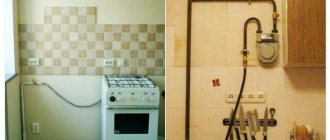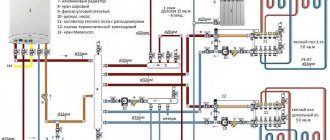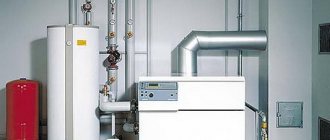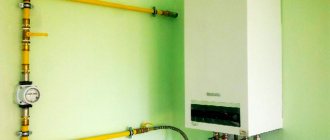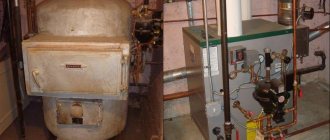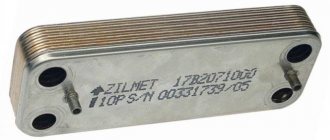A single-circuit or double-circuit gas boiler is equipment that makes our life in a house or apartment more comfortable. Manufacturers now produce a huge range of gas appliances, differing in power, functionality, and installation method. However, even the most expensive and reliable models can fail. Agree, it’s not very pleasant to be left on a winter evening without heat and hot water.
Having analyzed the possible causes of breakdowns of gas equipment, we came to the conclusion that most often malfunctions occur due to the fact that the pressure in the expansion tank of a gas boiler or water heater is incorrectly adjusted. In this article we will figure out why an expansion tank is needed, how to pump air into it yourself and set the optimal pressure.
Why is an expansion tank needed?
When heated, water tends to expand—as the temperature rises, the volume of the liquid increases. Pressure begins to increase in the heating system circuit, which can have a destructive effect on gas equipment and the integrity of the pipes.
The expansion tank (expanzomat) serves as an additional reservoir into which excess water formed as a result of heating is pressed out. When the liquid cools and the pressure stabilizes, it returns through the pipes back into the system.
The expansion tank acts as a protective buffer; it dampens water hammer, which constantly forms in the heating system due to frequent turning on and off of the pump, and also eliminates the possibility of air locks.
To reduce the likelihood of air locks and prevent damage to the gas boiler due to water hammer, the expansion tank should be mounted in front of the heat generator, on the return line
There are two different types of damper tanks: open and closed types. They differ not only in design, but also in the method and location of installation. Let's look at the features of each of these types in more detail.
Open expansion tank
An open type tank is mounted at the top point of the heating system. The containers are made of steel. Most often they have a rectangular or cylindrical shape.
Typically, such expansion tanks are installed in the attic or attic. Installation under the roof is possible. It is imperative to pay attention to the thermal insulation of the structure
The structure of the open-type tank has several outlets: for water inlet, cooled liquid outlet, control pipe inlet, and also an outlet pipe for coolant discharge into the sewer. We wrote more about the structure and types of an open tank in our other article.
Open tank functions:
- controls the coolant level in the heating circuit;
- if the temperature in the system has decreased, it compensates for the volume of coolant;
- when the pressure in the system changes, the tank acts as a buffer zone;
- removes excess coolant from the system into the sewer system;
- removes air from the circuit.
Despite the functionality of open expansion tanks, they are practically not used anymore. Since they have many disadvantages, for example, the large size of the container, the tendency to corrosion. They are installed in heating systems that operate only with natural water circulation.
Closed expansion chamber
In closed-circuit heating systems, a membrane-type expansion tank is usually installed; it is optimally suited for any type of gas boiler and has many advantages.
An expansomat is a hermetic container, which is divided in the middle by an elastic membrane. The first half will contain excess water, and the second half will contain regular air or nitrogen.
Closed expansion tanks for heating are usually painted red. There is a membrane inside the tank; it is made of rubber. A necessary element to maintain pressure in the expansion tank
Compensation tanks with a membrane can be produced in the form of a hemisphere or in the form of a cylinder. Which is quite suitable for use in a heating system with a gas boiler. We recommend that you familiarize yourself in more detail with the installation features of closed tanks.
Advantages of membrane types of tanks:
- ease of self-installation;
- corrosion resistance;
- work without regular addition of coolant;
- lack of contact of water with air;
- performance under high load conditions;
- tightness.
Gas attachments are usually equipped with an expansion tank. But the additional tank is not always configured correctly from the factory and can immediately start heating.
Preventing the problem from recurring
It is easier to prevent problems in the heating circuit than to suddenly look for ways to eliminate them. So before the start of the heating season, communications are checked by testing, especially focusing on dangerous areas.
These include:
- level spans;
- threaded connections and welds;
- zone of joining sections at radiators;
- places of implantation of heating equipment;
- near fittings;
- hard-to-reach areas.
First, everything is checked by eye, then with the circuit running.
Air pressure in the expansion tank
The air or nitrogen pressure in the expansion tank will not be the same for different gas boilers; it all depends on the type of equipment and design features. The standards are indicated by the manufacturer in the product passport.
Typically, the pressure in a new damper tank is 1.5 atm. But this setting may not be suitable for a specific heating system. Factory settings are easy to reset. For these purposes, there is a special fitting in the expansion tank housing (for some manufacturers this is a spool valve for pumping), through which the air pressure is adjusted.
The nipple is located on the side of the air chamber of the cylinder. With its help you can release excess pressure or, conversely, pump up the tank
For the normal functioning of a gas boiler, it is necessary that the pressure in the membrane tank be 0.2 atm less than in the system itself. Otherwise, the heated water that has increased in volume will not be able to enter the container.
In small houses and apartments for closed heating systems, the pressure in the expansion tank is usually acceptable in the range of 0.8-1.0 bar (atm). But not less than 0.7 bar, since many gas boilers have protection and the device simply will not turn on.
The tank pressure level should be checked annually. If pressure surges are noticed in the heating system, it means that air has come out of the damper tank and needs to be pumped up.
Open type hydraulic tank
Such designs are considered obsolete, since they do not provide absolute autonomy, and can only increase the period between maintenance. The heated liquid evaporates, and its shortage must be eliminated by periodically adding coolant to replenish its volume. No diaphragms or bulbs are used. Pressure in the system appears due to the fact that the open hydraulic tank is mounted on a hill (in the attic, under the ceiling, etc.).
Naturally, there is no air pressure in an open type expansion tank. When calculating, it is taken into account that one meter of water column creates a pressure of 0.1 atmospheres. However, there is a way to automate water collection. To do this, a float is installed, which, when lowered, opens the tap, and after filling the tank, it rises and blocks the access of water to the tank. But in this case, you still need to monitor the operation of the system.
How to set the optimal pressure?
The heating system has pressure gauges that control the pressure in the circuit. On the expansion tank itself there is no fitting for installing a measuring device. But there is a nipple or spool for releasing and pumping air or gas. The nipple is the same as on car wheels. Therefore, you can check the pressure level and adjust it using a conventional car pump with a pressure gauge.
Even a simple automobile hand pump with a pressure gauge or an automatic compressor will be suitable for pumping air into the expansion tank.
Before releasing excess pressure or pumping air into the expansion tank of a domestic gas boiler, it is necessary to prepare the system. The car pressure gauge shows the value in MPa; the data obtained must be converted into atmospheres or bars: 1 Bar (1 atm) = 0.1 MPa.
Pressure measurement algorithm:
- Turn off the gas boiler. Wait until water stops circulating through the system.
- In the area with the hydraulic tank, close all shut-off valves and drain the coolant through the drain fitting. For boilers with a built-in tank, the return flow is shut off, as well as the water supply.
- Connect the pump to the tank nipple.
- Pump up the air to 1.5 atm. Wait a little for the remaining water to pour out, then let the air in again.
- Close the valves of the shut-off valves and use a compressor to pump up the pressure to the parameters specified in the passport or to the level - pressure in the system minus 0.2 atm. If the tank is pumped, excess air is released.
- Remove the pump from the nipple, screw on the cap and close the drain fitting. Fill the system with water.
You can check the correct air pressure adjustment when the boiler reaches operating parameters.
If the tank is inflated correctly, then the needle on the pressure gauge of the device during measurement will show a smooth increase in pressure without any jumps or jerks
If the air pressure in the expansion tank is incorrectly adjusted, the entire heating system may malfunction. If the expansion tank is over-inflated, the compensating properties will not work. Because the air will push excess heated water out of the tank, increasing the pressure in the pipes of the heating system.
And with underestimated pressure readings of the compensating tank, water will simply push through the membrane and fill the entire tank. As a result, when the coolant temperature rises, the safety valve will operate.
Sometimes in double-circuit gas boilers, fuses work even if the pressure of the built-in expansion tank is correctly adjusted. This indicates that the tank volume is too small for such a heating system. In this situation, it is recommended to install an additional hydraulic tank.
Hydraulic tank maintenance rules
The essence of the audit is to check the pressure in the air chamber. The pressure gauge must be in good working order and have a measurement accuracy of 0.1 bar. You can use a car tire pressure gauge to check tire pressure. It is convenient when the scale contains gradations in atmospheres. Then you won’t have to recalculate if the instructions indicate pressure in other units.
If, as a result of pumping, the air pressure in the expansion tank does not rise, this may indicate that the bulb or membrane has failed and requires replacement. During the inspection, the nipple and valves are checked. They must be sealed.
It is important that this equipment maintains the parameters set by the manufacturer. There is no need to check the strength, but after pumping the air should remain in the gas chamber for a long time.
Purpose of an additional tank of a double-circuit boiler
As a rule, built-in compensation tanks in gas boilers have a volume of about 6-8 liters. They are designed to compensate for the expansion of 120 liters of coolant circulating in the heating system. Under normal operating conditions, such an expansion tank is enough for a small apartment or house.
When installing radiators of non-standard shape and size, the heating system must be equipped with an additional expansion tank. Because these batteries hold more water
If the heating area is large, heated floors are installed or there are many radiators in the rooms, the volume of the standard built-in tank will be small, since more water is used.
When heated, excess coolant completely fills the tank. And since there is no free space left in the tank, the water pressure increases in the heating system itself and an emergency release occurs by the safety valve. After this, it is unlikely that the gas boiler will be able to start working automatically.
To avoid such negative consequences, an additional expansion tank with a membrane is installed in the heating system in a design for a double-circuit gas boiler. When the standard tank is completely filled, the water goes into the reserve hydraulic tank. After cooling, the liquid returns to the radiators.
Operating principle and types of compensatory devices
If you are going to install a heating unit in a country house, then an expansion tank for heating (expanzomat) must necessarily appear in it.
The operation scheme of a compensation tank for heating is simple: as the temperature of the coolant increases, its volume (we are talking about water, since it is what is most often used for piping heating units) increases. Due to the fact that the circuit is closed, the liquid does not evaporate or burn, which, in turn, provokes an increase in pressure in the line, which must be reduced to avoid an emergency. This stabilization of pressure in the heating system is called compensation, and it is for these purposes that an expansion tank for heating is used.
Calculation of expansion tank volume
It is not difficult to ensure stable operation of the heating system; the main thing is to correctly select the volume of the compensation tank. The volume of the expansion tank should be calculated taking into account the most intensive operating mode of the gas boiler. When heating is first started, the air temperature is not yet very low, so the equipment will operate at an average load. With the arrival of frost, the water warms up more and its quantity increases, requiring more additional space.
It is recommended to select a tank with a capacity of at least 10-12% of the total amount of liquid in the heating system. Otherwise, the tank may not be able to cope with the load.
You can independently calculate the exact capacity of the expansion tank. To do this, first determine the amount of coolant in the entire heating system.
Methods for calculating the volume of water in the heating system:
- Completely drain the coolant from the pipes into buckets or other containers so that the displacement can be calculated.
- Pour water into the pipes through the water meter.
- The volumes are summed up: the capacity of the boiler, the amount of liquid in the radiators and pipes.
- Calculation based on boiler power - the power of the installed boiler is multiplied by 15. That is, for a 25 kW boiler you will need 375 liters of water (25 * 15).
After the amount of coolant has been calculated (example: 25 kW * 15 = 375 liters of water), the volume of the expansion tank is calculated.
There are many methods, but not all of them are accurate and the amount of water that fits into the heating system can be much greater. Therefore, the volume of the expansion tank is always selected with a small margin
The calculation methods are quite complex. For one-story houses, use the following formula:
Expansion tank volume = (V*E)/D,
Where
- D – tank efficiency indicator;
- E – liquid expansion coefficient (for water – 0.0359);
- V is the amount of water in the system.
The tank efficiency indicator is obtained using the formula:
D = (Pmax—Ps)/(Pmax +1),
Where
- Ps =0.5 bar is an indicator of the charging pressure of the expansion tank;
- Pmax is the maximum pressure of the heating system, on average 2.5 bar.
- D = (2,5-0,5)/(2,5 +1)=0,57.
For a system with a boiler power of 25 kW, an expansion tank with a volume of: (375*0.0359)/0.57=23.61 l will be required.
And although a double-circuit gas boiler already has a built-in 6-8 liter tank, looking at the calculation results, we understand that stable operation of the heating system will not be possible without installing an additional expansion tank.
Features of adjusting the hydraulic accumulator
Expansion tanks for water supply are sold with standard manufacturer settings - often the pressure in the air compartment is already set at 1.5 bar. The permissible pressure is always indicated on the label and the manufacturer does not recommend deviating from the specified parameters, especially in the direction of increasing it.
Before proceeding with the adjustment, the system is disconnected from the power supply and the shut-off valves are closed. The membrane tank is completely emptied by draining the water - an accurate pressure indicator can only be measured when the water compartment is empty.
Next, pressure readings are taken using an accurate pressure gauge. To do this, remove the decorative cap from the spool and bring the device. If the pressure differs from the required one, it is brought into compliance by pumping or bleeding excess air.
Considering that the manufacturer is against deviations from the recommended pressure values, it is necessary to select suitable equipment at the design stage, the parameters of which will not conflict with each other
When adjusting the pressure in the gas compartment of the tank, the manufacturer fills it with an inert gas, for example, dry nitrogen. This prevents corrosion of the inner surface. Therefore, users are also recommended to use technical nitrogen to increase pressure.
Setting the tank pressure in the water supply system
The pressure in a closed tank is always set slightly lower (by 10%) than the pressure level when starting the pump. By adjusting the pressure in the device, you can adjust the water pressure. The lower the gas pressure in the hydraulic tank (but not less than 1 bar), the more water it will hold.
In this case, the pressure will become uneven - strong when the tank is full and increasingly weak when it is empty. To ensure a strong and even flow of water, set the pressure in the chamber with air or gas to within 1.5 bar.
The water pressure in the water supply is set using a relay. When setting the pressure in the expansion chamber, these values must be taken into accountAdjusting the hydraulic tank in the water heater trim
The expansion tank, which is used for hot water supply, should initially not contain water. The pressure in the device is set at a value that is 0.2 greater than the upper pump shutdown threshold.
For example, if the relay is configured to turn off the equipment at a pressure of 4 bar, then the pressure in the gas compartment of the expansion tank should be set to 4.2 bar.
Installed in the water heater piping, the tank does not serve to maintain pressure. It is designed to compensate for expansion when water is heated. If you set the pressure in it to a lower value, then there will always be water in the tank.
How to drain water from a hose or pipe without removing the pump from the well
When preserving a pumping system for the winter, it is not always necessary to remove the pump itself. It will winter well in an insulated well or well, but hoses and pipes will have a hard time. When frost hits, the water in them freezes, and the ice has a lower specific density, it literally pushes the walls apart, and eventually they break. As a result, you come to the dacha to celebrate the New Year, and there the pump does not work, there is no heating, there is no water, and there is no mood either.
Draining water through the drain hole
A very simple and therefore popular method: you need to drill a hole in a pipe or hose between the freezing point and the static water level. The diameter should be small, 1-3 mm, you can make a hole with an awl, drill or nail.
Such a small hole does not affect the operation of the pumping system, but the water gradually pours out, which is what is needed.
Cons: cannot be installed on systems with automation and hydraulic accumulators. Water will have time to pour out during pauses between injections, air will begin to enter the system, resulting in breakdowns.
So the method is simple, but it also works with the same simple systems.
Complete disassembly of the pipeline system
The entire system can be simply disassembled, at the same time checking the condition of each element. This is useful from an operational point of view and extremely reliable, but it will require a lot of effort and time, especially if the system runs deep enough.
The method is suitable for shallow systems and for old pipelines that still need to be checked and replaced. But in most cases, people prefer not to complicate their lives.
How to drain water from the water supply system for the winter
Some owners of country houses and dachas use houses for residence only in the warm season, organizing an appropriate autonomous water supply from a well or well. After the end of their stay with the onset of cold weather, many homeowners are faced with the question of how to drain the water from the water supply system for the winter.
Not only the external and internal pipelines, but also the automatic elements of the electric pump and pumping equipment will have to be freed from water masses. The task is not so simple due to the presence in the house of a large number of plumbing and household electrical appliances, the operation of which is related to water consumption and residual water can be stored in these devices for a long time.
Rice. 1 Draining water from a house into a well - an example of a diagram of how to drain water from a water supply system for the winter
When and why is it necessary to drain water from the water supply system?
The presence of water in water pipes can lead to unpleasant consequences in winter when it freezes, associated with the well-known physical effect of the lower density of ice and its expansion compared to liquid by 10%. The second reason why water should be drained in the absence of owners for a long time is the corrosion of metals that occurs in its presence.
The following objects pose a threat of damage, failure with financial losses if there is water in them in winter:
- In autonomous water supply, water intake is mainly made from boreholes and borehole sources, while the pipeline is usually placed underground below the freezing depth. If the pipe is located above the freezing depth, then it must be dehydrated.
Rice. 2 Scheme of drainage in a caisson for a well - When drawing water, there is usually always water in a pressure pipeline immersed in a well or borehole. This is due to the fact that submersible pumps or the suction section of the pipeline of a surface pumping station are often equipped with a check valve. For a deep-well electric pump it is located at the outlet and is often built into the structure; for a station pipe it is at the end of its suction pipe. Therefore, to free a section of a pressure pipeline from water masses, various types of engineering solutions are used in the design or a suction pipe or electric pump is removed from the source.
- In a house abandoned in winter, the owners try to maintain minimal heating, otherwise severe frosts will damage the interior decoration of walls, ceilings, flooring, furniture, household appliances, and household items. However, in order to avoid unforeseen situations, water is drained from the internal plumbing system just in case.
- Pumping equipment and the electric pump itself are usually dismantled for winter, and the water must be drained from all components.
- When not in use, dacha household appliances (washing machines, dishwashers) and water heating equipment contain water residues that lead to corrosion and can cause damage to the units when they freeze.
- There is also water in the water seals of plumbing fixtures and it is advisable to remove it.
Rice. 3 Valve drain in wells
How to drain water from the water supply system for the winter - stages of work
Many users solve the problem of how to properly drain water from a water supply system for the winter in different ways; if the procedure was not previously structurally provided for, its implementation becomes more complicated. Some “Internet experts” recommend using a compressor to blow out the entire system to pump out water.
